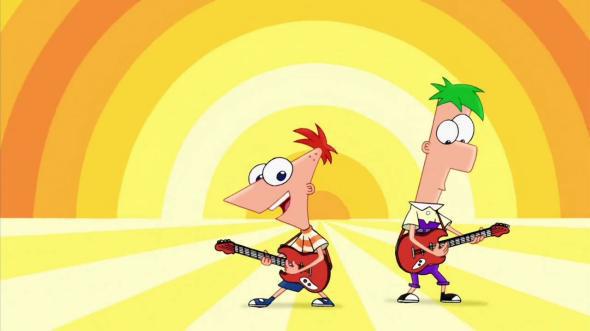The upcoming finale of Phineas and Ferb has me thinking about all the great music the show has brought into my family’s life: Songs in every imaginable genre (Country and western! Ska! Metal! Bollywood!) that my child and I are both willing to watch, sing and harmonize poorly on over and over again, to what we’ve convinced ourselves is the quiet yet abiding joy of her father. Narrowing down the choices for this top 5 list was such pleasurable hard work, it should have been scored to this theme.
5. “A-G-L-E-T.” One morning when my daughter was tying her sneakers, she observed that the hard piece of clear plastic at both ends of a shoelace is called an “aglet.” “How did you know that?” I asked, in my customary state of perplexity at her ability to learn things when I’m out of the room. She immediately burst into the refrain from the song of the same name, from “Tip of the Day,” in which Phineas and Ferb briefly make this obscure vocabulary word the object of a national (or at least Tri-State-wide) craze. “A-G-L-E-T! Don’t forget it!” chant the citizens of Danville at the Live Aid-style aglet benefit concert, and after hearing this song one time, you won’t.
4. “Summer Belongs to You.” During my interview with the show’s creators, Dan Povenmire and Jeff “Swampy” Marsh, they both mentioned this big number, which ends the second-season special episode of the same title, as one of their favorites of the hundreds of songs they’ve co-written for the show (in this case, with Danny Jacob and Martin Olson). Several of the series’ best songs (including the opening theme) celebrate the unique joys of the season in which it’s set. There’s the earworm “Summer (Where Do We Begin?)” (from the Disney Channel movie Across the 2nd Dimension, whose soundtrack is pretty solid across the board). Or the Christmas carol-like “S’Winter,” from an episode by that name in which the kids use a souped-up snow-cone machine to turn the hottest day of the year into a backyard ski holiday. But of all Phineas and Ferb’s estival odes, it’s this song’s infectious affirmation of the creative possibilities of summer that best sums up the series’ life philosophy.
3. “Whalemingo.” Buford Van Stomm (voiced by Bobby Gaylor, a Phineas and Ferb writer who’s also collaborated on many of its songs, including this one) is Danville’s reigning elementary-school bully—albeit one who secretly dances ballet, speaks impeccable French, and dreams of becoming a pixie. Buford doesn’t get many storylines, let alone songs, to himself, which makes his mystical ode to the intergalactic whale-flamingo hybrid he befriends in “When Worlds Collide” all the more special.
2.“There’s a Platypus Controlling Me.” I couldn’t make a top five Phineas and Ferb song list without including a solo from my favorite character (and, I sometimes fear, innermost self), Dr. Heinz Doofenshmirtz. I haven’t heard a Doof song yet I don’t love—up to and including his highly versatile evil jingle (which we hear him tinkering with at the piano in one episode, wondering if he should add another verse or two). But if you’re looking for a single musical example of the abject incompetence and desperate desire to be loved that are this bumbling villain’s two key attributes, it doesn’t get better than this song from the episode “Brain Drain.” No need for a setup here, since, as always, Doofenshmirtz is happy to provide his own backstory.
1. “Carpe Diem.” I would wager that this ancient Roman dictum—originally from Horace’s Odes, revived as a theme in Elizabethan poetry, familiar to most of us as the motto of Robin Williams’ unconventional prep-school teacher in Dead Poets Society—hasn’t had a catchier musical treatment in centuries than it got in the grand finale to “Rollercoaster: The Musical.” This second-season episode marks a turning point in the show’s history, a moment when you can feel its creators claiming their own defiantly weird voice. An almost line-for-line remake of the very first episode, but this time with Broadway-style production numbers, it’s a daring formalist experiment that works like gangbusters, in no small part because every member of the already-stellar voice cast can sing, in character, in whatever register is required. It was after “Rollercoaster: The Musical” that Phineas and Ferb’s musical inventiveness started to take off like … well, like a bunch of kids strapped to a giant rubber-band ball, bouncing around the world.
